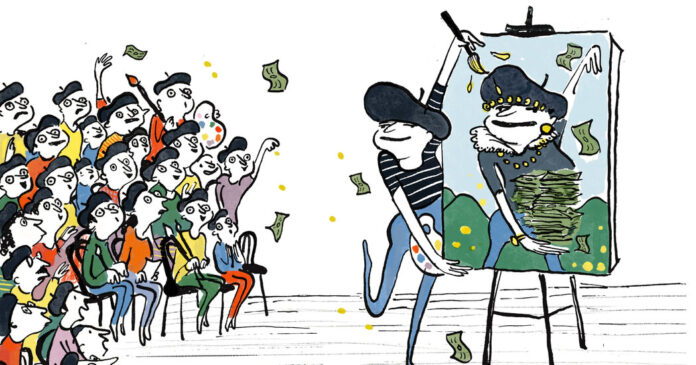The idea is simple: Artists upload high-resolution images of their work. A fulfillment center prints and ships editions in a range of sizes directly to consumers on materials ranging from wall-mounted canvases and acrylic panels to yoga mats and tank tops. AI-powered statistical analytics tracks your potential buyers; a marketing calendar maps out your social media strategy. The bespectacled sales rep showed me a summary of one artist's annual earnings: over $80,000. If I signed up in the next few hours, he said—for $1,699 up front for the basic Bronze membership, plus $50 a month for the web store—they would build my website for me. And I would supposedly start collecting money.
Art Storefronts was founded in 2013 and now has 14,000 members. Nick Friend, the company's CEO and founder, is a graduate of USC's Marshall School of Business. He came up with the idea for Art Storefronts after starting a company that produces art paper and canvases.
The Art Storefronts website states: “Selling art? Marketing is all that matters.”
From the moment I gave out my contact information, I was blindsided by their aggressive sales pitches: emails and text messages luring me with one of the few spots in their recent limited promotion. Other emails promising more tours with satisfied Art Storefronts customers.
“I've seen so many ads now, these videos, you know: Artist, I can help you make $500,000 and blah, blah, blah. And that's always the promise,” said Karen Hutton, a veteran landscape and travel photographer. She sells several images through a storefront website of sorts, but that's only part of a successful career. “I have a vision of what I want my business to be,” she told me. “Her business education doesn't fit that. And that's OK, because it fits other people.”
Ideally, says a testosterone-fueled 2017 Art Storefronts podcast episode (which was removed from the site a few weeks ago), prospective members are encouraged to pass what's known as the “Is my art crap?” test by selling their art offline to a stranger.
A friend told me that 20 percent of new members had never sold art before. Art Storefronts also seemed willing to take my money—a marketing email said my art had “accidentally” caught the eye of a representative. But I hadn't shown it to anyone.















